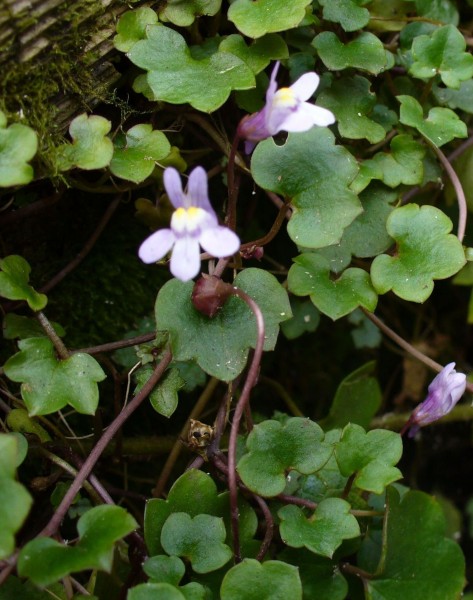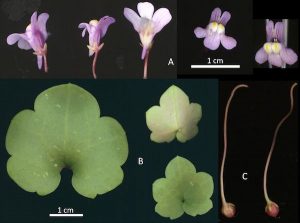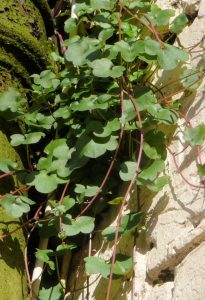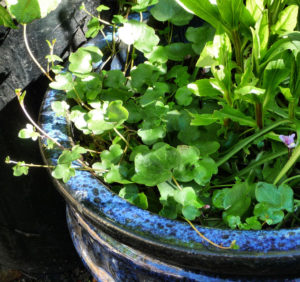IVY-LEAVED TOADFLAX (Cymbalaria muralis)
Mediterranean Europe
Now a resident UK wildflower, this dainty plant from southern Europe was brought to The Chelsea Physic Garden over 300 years ago. Ivy-leaved Toadflax grows on old walls, its thin & fibrous roots insinuating themselves into crevices in dry rocky places, between pointing in brickwork, along paving stones.
The glossy evergreen leaves of Cymbalaria Muralis are purple underneath; in full sun the stems, stalks & undersides of its flowers are tinged with purple. The flowers, tiny LILAC snapdragons, are visited by bees. They bloom from May to September/ October in the UK ( January to December in New Zealand, see link to Julia’s Edible Weedsblog below).
“Ivy-leaved toadflax’s lacelike stems can grow up to 80cm long. It has a remarkable method of propagation. The flower stalk starts out as positively phototropic meaning they grow towards the light to attract pollinating insects. Once fertilised the flower stalk becomes negatively phototropic and moves away from the light into dark cracks and crevices where the seeds germinate.”
https://www.juliasedibleweeds.com/general/ivy-leaved-toadflax/
In BBC’s The Private Life of Plants, David Attenborough describes how the flowers of Ivy-Leaved Toadflax turn to the wall on which they grow to disperse their tiny seeds. This self-seeding mechanism can be used indoors, where the plant can be persuaded to grow in a container on a windowsill.
Edible Ivy-leaved Toadflax
‘It is eaten as a salad, being acrid or pungent like Cress, and it was endowed with antiscorbutic properties.’
A R Horwood. British Wild Flowers in their Natural Haunts, The Gresham Publishing Company, 1919.
‘It has a high vitamin C content. We use the flowers & leaves mainly in salads. You can harvest for a long period of time, & its taste is a bit acrid and pungent like cress.’
http://www.wildplantforager.com/blog/1
“Ivy-leaved Toadflax is high in Vitamin C. It tastes pungent and acrid but is great mixed in with other greens. It is said to have been used in India to treat diabetes.”
from a blog on Ivy-Leaved Toadflax from Julia’s Edible Weeds. Her site looks at identifying weeds in your garden & making health-giving green smoothies & salads from those weeds. The UK & NZ do share some weeds/wildflowers, i.e. Ivy-Leaved Toadflax… https://www.juliasedibleweeds.com/general/ivy-leaved-toadflax/
https://www.jeremybartlett.co.uk/2020/11/30/ivy-leaved-toadflax-cymbalaria-muralis/ jeremy bartlett’s LET IT GROW blog There are over 10 years of these blogs, always a good read.
Historical Ivy-leaved Toadflax
‘This plant is a part of every medieval city wall.’ In France, ‘Clinging to the massive masonry that lifts Chateaudun above the Loire Valley, it undoubtedly felt the breath of molten lead poured on the enemy from the apertures above and received many a misdirected arrow from below.”
After its introduction into Britain, it climbed the walls of Kenilworth Castle with such enthusiasm that it earned itself the name ‘Kenilworth Ivy’.
May Thielgaard Watts, Reading the Landscape of Europe, Harper & Row, 1971.
‘Cymbalaria… runneth and spreadeth on the ground and clymeth and hangeth on walls even as Ivie or Chickweed doth, the branches are verie small, round and smooth, limmer and pliant.’
John Goodyer, 17th C Botanist
‘This diminutive plant grows in my walls at home, forming a delicate veil of foliage embroidered with tiny lilac flowers from April until October. During mild winters flowering may be continuous, with each bloom resembling a Lilliputian Snapdragon. The effect is magical, as if the plant rightly belonged to a miniature world where where fairies employed it to hide their tiny front doors from prying eyes.’
Dan Cooper, The Frustrated Gardener, Plant Profile Ivy Leaved Toadflax, Mozilla Firefox
Other names: Aaron’s Beard, Climbing Sailor, Coliseum Ivy, Creeping Jenny, Devil’s Ribbon, Female Fluellen, Fleas and Lice, Ivy Weed, Ivy Wort, Kenilworth Ivy, Kentucky Ivy, Mother of Millions, Mother of Thousands, Oxford Ivy, Oxford Weed, Pedlar’s Basket, Penny Leaf, Penny Wort, Rabbits, Roving Sailor, Thousand Flower, Wandering Jew, Wandering Sailor. Muurleeuwenbek (Dutch); Cymbalaire des murs, Ruine-de-Rome (French); Zimbelkraut (German).
Ivy Leaved Toadflax in Highbury
Cymbalaria Muralis’ froth of delicate green leaves appears all around our Highbury streets, especially between pavement and walls. It is a treat for the eye, especially when the tiny lilac flowers are in bloom. But the council treat it as a weed and it is strimmed away periodically with neighbouring tiny weeds, to neaten the appearance of the street.
Trying to grow it in this garden has been difficult. A lovely clump of it by the house was eaten, perhaps by mice, last winter when one would have expected the leaves to remain evergreen. Because of its size, just when it appears to have found its niche and be flourishing, a neighbouring plant will lean over and take its access to sunlight away.





